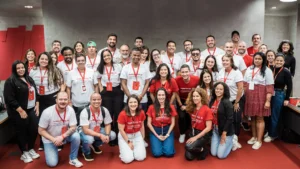Technology is present from the moment you open the app — and it also improves the work of restaurants and delivery people
Who are you on the iFood app? It doesn't matter whether you place an order, prepare a meal, deliver food or sell products: in any scenario, the artificial intelligence (AI) will follow you closely. Without it, it would be unimaginable to deliver 65 million orders per month, coming from more than 300,000 establishments and transported by 200,000 delivery partners.
On iFood, artificial intelligence is an essential ally to bring insights for restaurants, markets and pharmacies, consumer satisfaction and more earnings for delivery people. “The application of AI in iFood meets this tripod”, he explains Marcos Gurgel, director of innovation at IFood. And technology also acts as a kind of sentinel to bring more security to platform.
The most applied artificial intelligence technique in the company is machine learning (or machine learning), in which the computer uses data to learn how to perform a task. To do this, you must have data, computational power and a challenge (the problem to be solved or the benefit to be provided). “Few places have these ingredients to be able to work with machine learning and real artificial intelligence, like we do”, says Thiago Cardoso, director of Data Science at iFood. Discover below how AI helps those who use the iFood app.
Tailored recommendations for customers
Having an application at your fingertips the way you like it is only possible because there is artificial intelligence operating behind the scenes. “The entire user journey in the app has AI”, says Cardoso. Recommendations (of restaurants or categories), search results and even the messages you receive are the result of artificial intelligence.
Recommendations arise because there is a lot of data running on the platform (anonymized, it is worth noting), and they help to define the behaviors of different customer profiles. “What the algorithm does is try to see who has a similar taste to yours to suggest something for you to eat or order”, explains Cardoso.
Artificial intelligence also works in payment fraud prevention —when malicious people try to pass cards on iFood that are the result of robbery or theft, for example.
What teaches artificial intelligence to make a judgment about the transaction is to understand whether that person's behavior is normal or suspicious. “Registering several cards in an account to buy on iFood, for example, is not a normal action”, explains Cardoso. In a situation like this, with a high probability of fraud, payment is refused.
Insights for those who sell on the app
Did you know that AI can help a restaurant create the best menu to use in the iFood app? This happens because these partners receive, free of charge, information such as the ideal quantity of items, the best order of presentation and the price in relation to the region average. “We work with this wealth of data to show what is happening and what can be done to sell more”, says Gurgel.
Artificial intelligence also analyzes the catalog of those selling on the platform and monitors the texts to avoid offense, use of swear words and offering products that cannot be sold on iFood. “Imagine doing this work manually? It would take an army of people to map all of this”, he adds.
To avoid situations of this type, artificial intelligence learns patterns. If a person changes a letter in a word to a number to form a swear word, the AI can understand that this combination is strange and that something needs to be done, even if this is the first contact with that word or expression.
More agility and gains for delivery people
AI also works hand in hand with delivery partners. Your task is to distribute orders intelligently. By defining the preparation time for a meal (among other variables), the algorithm chooses who is in the best distance to pick up the order. This calculation also prevents professionals from wasting a lot of time waiting for the order to be finalized or separated.
Also thanks to technology, delivery drivers receive valuable information in the app: the heat map that shows which regions of the city have a concentration of orders. “This way, they know that in a certain location they will be more likely to make more money,” says Gurgel.
The Director of Innovation also explains that, within the company, AI is also a crucial tool for areas that need to quickly decide whether a strategy will move forward or be discarded. “A while ago, we decided to offer promotions for items close to their expiration date. Without AI, it would take a long time to learn how or when to do this and more time and resources would be consumed in making decisions”, he recalls.


